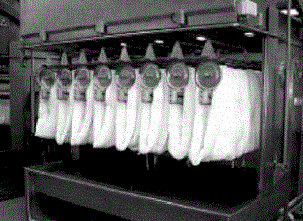What is Skein Dyeing?
Skein dyeing is a method of dyeing yarn or thread in which the material to be dyed is wound into a loose, untwisted coil or skein. Skein is the length of a yarn wound in a loose coil. The skein is then immersed in a dye bath, which may be a hot or cold water solution containing a dye substance. The dye bath can be applied by different methods, including immersion, pouring, or spraying.

Skein dyeing is also called hank dyeing. It consists of immersing large, loosely wound hanks (skeins) of yarn into dye vats that are especially designed for this purpose. Soft, lofty yarns, such as hand knitted yarns are usually skein dyed. This dyeing is the most costly yarn-dye method.
In skein dyeing, the yarns are loosely arranged in skeins or coils. These are then hung over a rung and immersed in a dyebath in a large container. In this method, the color penetration is the best and the yarns retain a softer, loftier feel. It is mostly used for bulky acrylic and wool yarns.
Working Process of Skein Dyeing Machine:
Skein dyeing machine is the most suitable machine for dyeing delicate yarns (Silk, Bemberg, etc.) since it prevents the material being too tightly packed; in fact other skein/hank dyeing systems frequently produce an excessive packing of the dyed material. The machine is equipped with horizontal arms perforated in the upper part; skeins are stacked and suspended on this rack. The liquor, forced through the arm holes, penetrates the skeins and is then collected in an underlying vat. Standard machines are equipped with a rod which moves the skeins at preset times, changing the bearing point to obtain a more uniform dyeing. During the skein motion, the flow of the liquor is stopped to avoid the formation of tangles in the yarn; since yarns are not fixed to rigid supports, they can thoroughly shrink. This machine does not run under pressure. It is possible to dye at steady temperatures since the liquor is contained in a separate tank.

Figure 2: Modular skein dyeing machine with pullout arms. Pullout arms also allow the loading and unloading of skeins far from the dyeing machine, without manually intervening in the intermediate dyeing, squeezing and drying operations. It can be used for silk, cotton, viscose and Cashmere yarns.
The operating costs of this machine are generally very high because it require a very high liquor ratio (1:15 | 1:25 | 1:30). Standby times for loading and unloading operations are also very high and the arms must be often cleaned. This machine can be used also for scouring and finishing processes.
Some machine manufacturers have designed machines with slant covers to avoid unwanted liquor dripping on the skeins; the skein rotation is determined by the perforated arms, and not by the rotation of the skein-lifting device when the arm is stopped; it is therefore possible to eliminate the sliding contact with the skeins and preserve them perfectly.
There are also package dyeing machines with triangle-shape arms, arranged radially on a variable-speed rotor. When the dyeing process has terminated, the material can be centrifuged and dried, by forcing a hot air flow into the arms and through the skeins.
Conclusion:
Skein dyeing is a popular method for dyeing natural fibers such as wool, cotton, and silk, as well as synthetic fibers such as polyester and nylon. It is used to produce a wide range of colors and shades, from subtle pastels to bold and vibrant hues. Skein dyeing is commonly used in the textile industry for producing colored yarns and threads for use in weaving, knitting, and other textile production processes.
You may also like:
- Garments Dyeing: Process, Machines, Advantages and Disadvantages
- Supercritical Fluid Dyeing: Need of the Future
